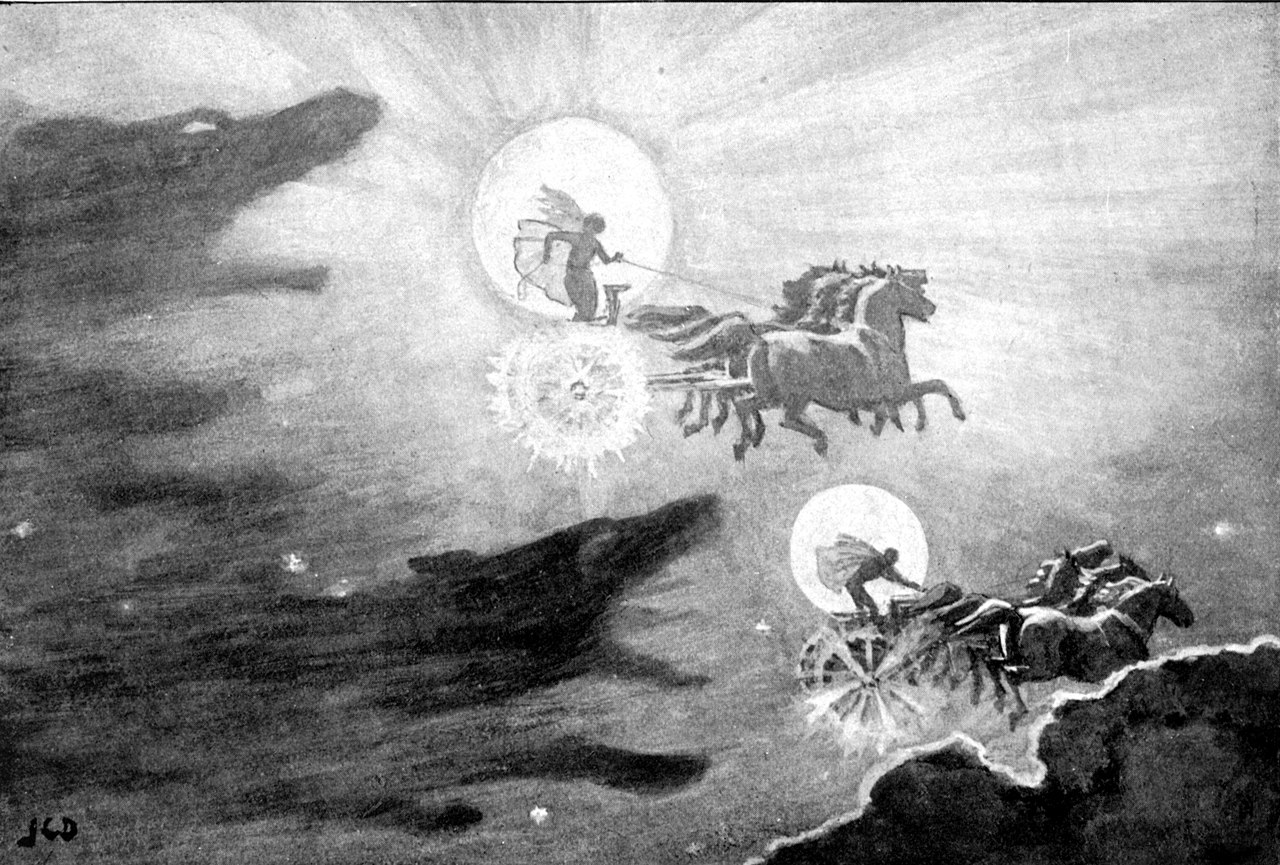Sol and Mani, in old Norse, translates quite literally to the sun and moon. They are known as the beings and Norse deities who drove the Sun and Moon in their courses through the sky. There isn't much known about Sol and Mani, but Snorri Sturluson's account in the Prose Edda offers some insight.
How Sol and Mani Came To Be
Unlike other Norse deities, Sol and Mani were born of a Midgardian human named Mundilfari. In his arrogance, he named his children after the sun and the moon, and this boastful naming of his children angered the gods.
Some scholars believe that the gods punished Mundilfari by naming his children after celestial bodies. In contrast, others think they punished him because he arranged a marriage between Sol and Glen (Glen is also an alternate name for Glær, one of the horses listed among those ridden by the gods).
The Poetic Edda and Snorri’s Prose Edda do not provide much insight into why these two human children were banished to the sky.
Sol and Mani don’t guide the sun and moon across the sky willingly. Two great hounds chase them. Every day, they must keep up a furious pace to avoid being devoured by the wolves Skoll and Hati (which translate to ‘Mockery’ and ‘Chase’).
The wolves’ names may indicate that Mundilfari’s punishment was due to his prideful naming of his children.
The old Norse myths predict Sol and Mani will eventually be caught by their wolf pursuers. Once devoured by the wolfs, the sun and moon will be extinguished from the sky, and all of the stars in the sky will go dark. The death of Sol and Mani is one of the first markers of the end of days, also known as Ragnarök.
Sol’s Fate
Sol, or Sunna or Sól, pulls a horse-drawn sun chariot over the sky, guiding the sun on its path. The horses that pull this carriage are called Árvakr and Alsviðr, which translates to Swift and Early Riser. In her horse-drawn carriage is a man named Svalinn, who holds a shield. Without Svalinn having this shield to block the earth, the land would erupt into flames.
A hound chases the goddess of the sun by the name of Skoll, the son of Fenrir. When Skoll ultimately devours Sol, as foretold in Norse myths, it summons Fenrir, which begins the epic battle between the gods: Ragnarök.
But all is not lost when the sun god falls. Before her death, she gives birth to a daughter (also named Sol) that will illuminate the new world (Gimle) after the events of Ragnarök.
Mani’s Fate
Mani, or Máni, is the god of the moon. According to Snorri Sturluson in the Prose Edda, Mani controlled the course of the moon and the waxing and waning moon. Mani kidnapped two Midgard humans named Bil and Hjúki, whom he followed through the sky. When the moon waxes or wanes, old Vikings believed it was the reflection of Bil and Hjúki in the sky.
Some scholars even believe that the ‘man on the moon’ is the personification of Mani. While there isn’t much known about Mani through the Poetic Edda, most of these tales come from Snorri Sturluson’s Prose Edda and old Icelandic kennings.

Sol and Mani Attestations in Old Norse Sagas
Sol and Mani are referenced in the Poetic Edda, albeit briefly. In the Völuspá, a seeress tells Odin of the sources of the sun and the moon, as well as the fate of the gods when Sol falls. It’s a brief passage but lends insight into their origin, father, and eventual fate.
We learn more about their heritage and future when Snorri Sturluson pens the Prose Edda. In chapter 12 of the Gylfaginning, we know that Sol and Mani are the steerers of the sun and the moon as a punishment sent down from the gods. This passage of the Gylfaginning describes why they were cast into the heavens and details the wolves pursuing Sol and Mani.
We learn that the death of Sol and Mani by the hounds extinguishes light from the sky and brings forth Ragnarök, the battle between Æsir gods (Thor, Tyr, and other Norse goddesses and gods) and the jötunn (giants such as Loki and Surtr).
Sol and Mani’s symbolism and fate: Punishment or Promotion?
Mentions of Sol and Mani in the original Norse texts in the Poetic Edda are fleeting. We know that they guide the sun and the moon, and wolves pursue them. However, the Poetic Edda doesn’t suggest that the fates of the sun and moon gods are punishments. They are potent gods, after all, and the germanic peoples often prayed to Sol and Mani for bountiful harvests and thanked them for the sun’s nourishment.
When Snorri Sturluson penned the Prose Edda, he interpreted Sol and Mani’s pursuit throughout the heavens by wolves as punishment, but that might not have been the case. Snorri wasn’t a Norse pagan but rather a Christian. It’s possible that he was influenced by Christian ideals of punishment when he interpreted Sol and Mani’s position as wolves pursued them.
Much of what we know of Sol and Mani comes from Snorri Sturluson’s interpretation of the Poetic Edda, which may or may not be entirely accurate.

